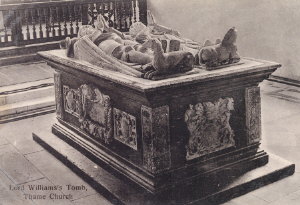
The Tomb of John Williams in St Mary's Church
Sir John Williams, later Baron Williams of Thame, was born in 1500.
He was without doubt one of the most influential men in the history of Thame, and at times a man of great influence on the national stage.
His importance to Thame in a nutshell is that he was the first secular person to hold the manors of Thame. The manors were relinquished by the Church following the Reformation under King Henry VIII.
Once in the hands of Sir John Williams, the manors were private property, and passed from one person to another through inheritance and marriage.
Sir John Williams lived at Rycote Palace, which although not part of the manor of Thame was acquired by him as his primary residence.
At the Dissolution of the Monastries, he also acquired Thame Park, a former Cistercian Abbey with substantial park land.
Sir John Williams, then Baron Williams of Thame, died in 1559, and in some ways his greatest legacy to Thame came about through his will.
Through the terms of his will, Thame Grammar School was endowed, built ten years after his death.
He also endowed Thame Alms Houses, redeveloped during his lifetime.
In another way, his legacy lies in the fact that his two daughters married into the Norreys and Wenman families.
The Norreys line became the Bertie family, Earls of Abingdon, who were lords of the manor of Thame and owners of Rycote until the nineteenth century.
The Wenman line lived at Thame Park for several generations, and built the grand Palladian country house we see today.
These pages draw heavilly on the chapter on John Williams in A Short History of Thame School, J. Howard Brown, 1927
Thame Park
Thame Grammar School
Thame AlmsHouses
The Wenmans